|
A successful final workshop
Posted on 24 November 2022 |
|
We are very grateful to Vincent Ménoret, Jean Lautier-Gaud and Peter Rosenbusch (iXblue / exail) for having organized a successful and enjoyable workshop at iXblue’s
headquarters (Talence, France; 18/11/2022). Indeed, it attracted a large online attendance, with more than 80 virtual participants! During the workshop, in-person attenders
were taken on a guided visit to iXblue’s labs, where AQGs are assembled and tested. Several instruments, at different stages of integration, were shown to the visitors,
including the prototype of iXblue’s Differential Quantum Gravimeter, able to simultaneously measure the local gravity and its vertical gradient. The workshop presentations,
given by representative of the project partners, were recorded and can be viewed from the YouTube channel of NEWTON-g at this
link.
|
|
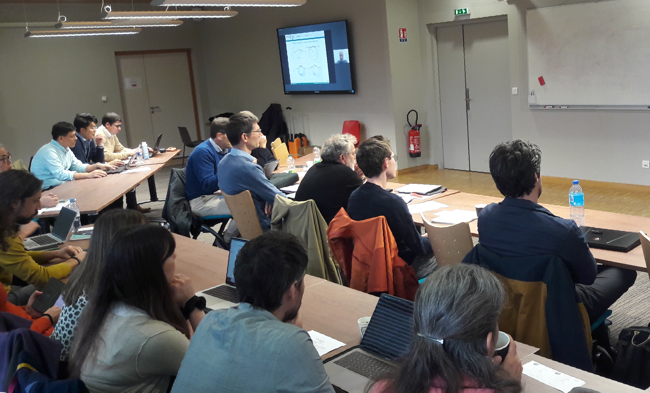 |
|
Final workshop
of NEWTON-g (18 November 2022)
Posted on 13 October 2022 |
|
The Final NEWTON-g workshop will be held at iXblue's premises in Talence (France), on 18 November 2022.
Online attendance will be also possible.
The workshop aims at presenting the results achieved in the framework of the project and the possible future developments beyond NEWTON-g. Participants will be also taken on a guided
tour of the laboratories in iXblue's premises, where the AQG-B has been developed.
To register, please fill the form here before 11 November 2022.
|
|
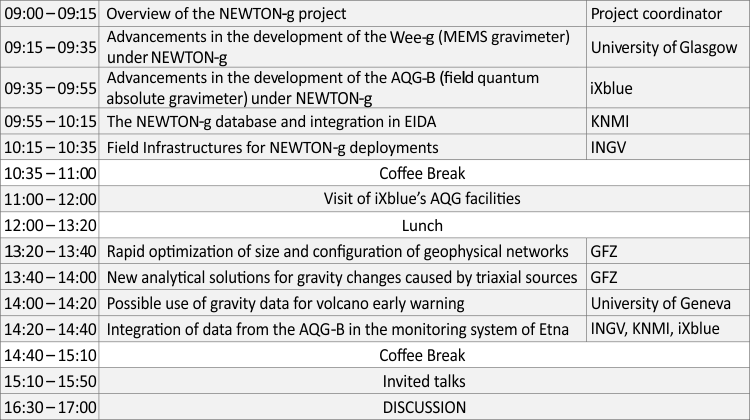 |
|
New tools for the joint inversions of deformation and gravity data
Posted on 8 September 2022 |
|
A paper entitled “Surface deformations and gravity changes caused by pressurized finite
ellipsoidal cavities” was published in Geophysical Journal International. It is the result of the work carried out by the GFZ team under WP4 of NEWTON-g and, together with the
point source solution, previously published in GRL, this paper builds a framework to carry
out joint inversions of surface deformation and gravity changes.
The MATLAB codes associated with both papers can be downloaded from
here.
|
|
 |
|
Other wee-gs deployed on Etna
Posted on 8 September 2022 |
|
During the summer of 2022, new wee-g devices (MEMS gravimeters)
were deployed in the summit zone of Etna, at elevations ranging
between 2600 and 3000 m. This activity was carried out by
members of the UNIGLA-IGR and INGV-OE teams. In some cases, the
instruments were deployed in sites where no previous facility
existed. Hence, a complete field infrastructure was also
installed to ensure full protection and functionality of the MEMS gravimeters, against severe field conditions.
|
|
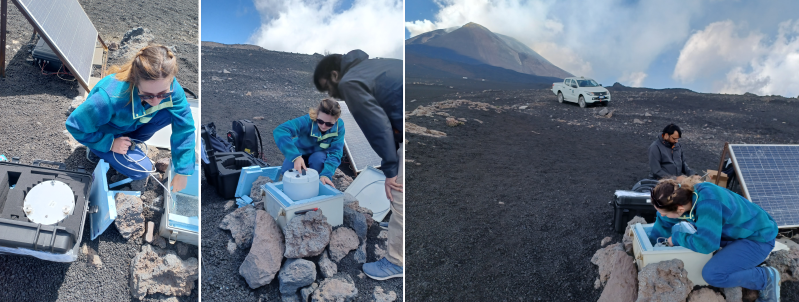 |
|
Another NEWTON-g paper is out!
Posted on 30 June 2022 |
|
A new paper entitled “Detecting Volcano-Related Underground Mass Changes With a Quantum Gravimeter” was published in Geophysical Research Letters.
It is an open access publication and can be reached through this link.
In this paper, authored by members of the INGV and iXblue teams of NEWTON-g, we present the first gravity data from AQG-B03, which was installed on Mt. Etna in 2020, in the frameworks
of activities under WP3. This is the world's first time series acquired with an absolute quantum gravimeter in the summit crater zone of an active volcano!
|
|
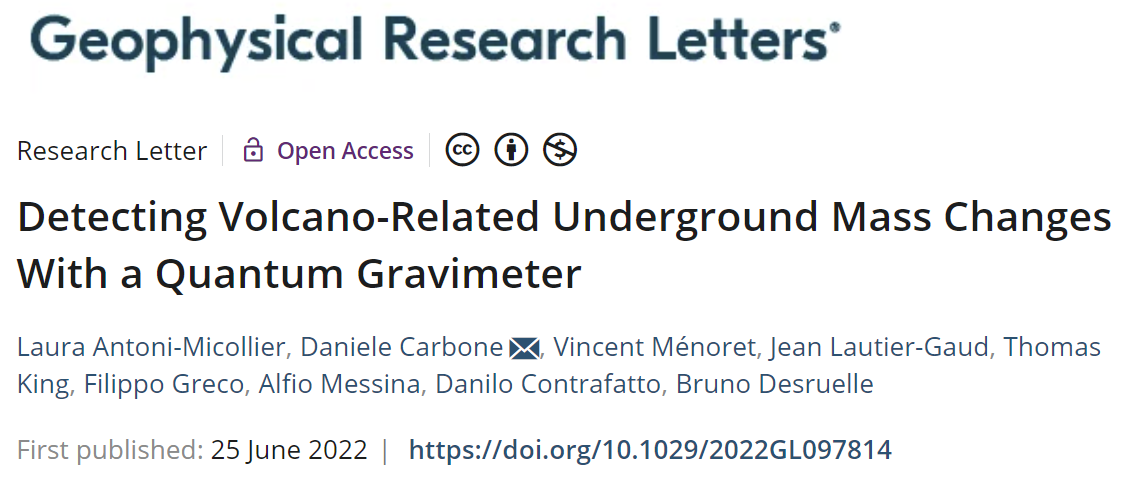 |
|
Session G4.4 at EGU 2022
Posted on 1 June 2022 |
|
During the 2022 edition of the EGU General Assembly in Vienna (23–27 May 2022), the session
“New tools for terrain gravimetry”, organized and convened by members of the NEWTON-g
consortium, was held in presence for the first time in three years. 13 presentations were given, covering many aspects of terrain gravimetry. Among them, those given by K. Anastasiou,
D. Carbone and M. Nikkhoo were focused on results of different
NEWTON-g's activities.
|
|
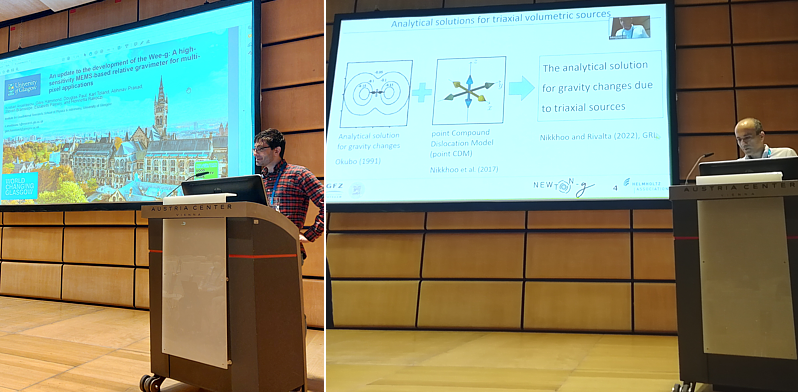 |
|
The first in-person meeting in > 2 years!
Posted on 11 March 2022 |
|
On 7 and 8 March, we held the first in-person project meeting in more than two years! The 7th NEWTON-g General Assembly was held at the Department of Physics (Institute Augusto Righi)
of the University of Bologna. During the GA, the consortium discussed all the issues related to the implementation of the project activities throughout the last 9 months of NEWTON-g.
Participants also had
the opportunity to enjoy traditional Emilian cuisine during the social dinner of the 7th.
|
|
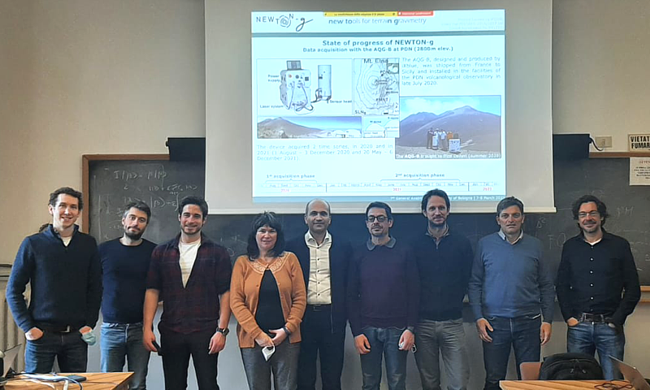 |
|
NEWTON-g presented at the 2021 ORFEUS Annual Workshop
Posted on 11 November 2021 |
|
An overview of the NEWTON-g project, including the planned technical integration with ORFEUS for data storage and dissemination, was presented at the ORFEUS annual workshop.
This work is partially being carried out in the framework of a software development grant provided by ORFEUS.
ORFEUS (Observatories & Research Facilities for
European Seismology) is a non-profit organisation that traditionally promotes the coordination of broadband seismology in Europe,
but has always expressed interest in embracing more types of geophysical data. In lieu of this, the November 8-9th, 2021 workshop was focused on discussion about the integration of
different data types and communities (e.g., DAS, GNSS, OBS, infrasound, gravity, rotational sensors) with the existing data infrastructure.
A shared infrastructure between many types of data facilitates the integration in larger multi-disciplinary systems. This is of particular interest to volcano monitoring systems, with a
focus on early warning and hazard assessment, that requires input from multiple sources. NEWTON-g is dedicated to contribute to this goal by leveraging existing standards and producing
FAIR gravity data.
|
|
 |
|
Movies from
the 2nd workshop of NEWTON-g
Posted on 2 November 2021 |
|
The 2nd NEWTON-g workshop was held online on 25 October 2021. Following the request from some colleagues outside Europe, who were not able to attend because of inconvenient timing, we recorded
the workshop presentations. They can be viewed from the following links.
Overview of NEWTON-g [00:26:48] - D. Carbone
(INGV; project coordinator)
The MEMS gravimeter + First
results from Mt. Etna [01:05:59] - K. Toland and K. Anastasiou
(UNIGLA), M. Koymans (KNMI)
The AQG-B gravimeter + First
results from Mt. Etna [00:53:44] - V. Ménoret (iXblue), T. King
(INGV)
Optimization of size and configuration of geophysical networks [00:28:38] -
M. Nikkhoo (GFZ)
New analytical solutions for gravity changes [00:30:46] -
M. Nikkhoo (GFZ)
A model for gravity changes induced by lava fountains [00:28:18] - L. Passarelli and V. Freret (UNIGE)
Advances and challanges of hydrogravimetry (invited talk) [00:33:44] -
M. Reich (GFZ)
The Kīlauea gravity experience (invited talk) [00:34:22] -
M. Poland (USGS)
|
|
 |
|
2nd workshop of NEWTON-g (25 October 2021)
Posted on 01 October 2021 |
|
The 2nd NEWTON-g workshop will be held online on 25 October 2021.
Physical attendance will be allowed at INGV-OE (Catania, Italy), only if current COVID restrictions are lifted.
The workshop aims at presenting the current state of the project. Two invited talks will be also given by eminent end-users of the gravity method in geophysics.
We think that the already achieved project results are of wide interest and we thus expect a large participation of gravity enthusiasts!
To register, please fill the form here before 22 October 2021.
|
|
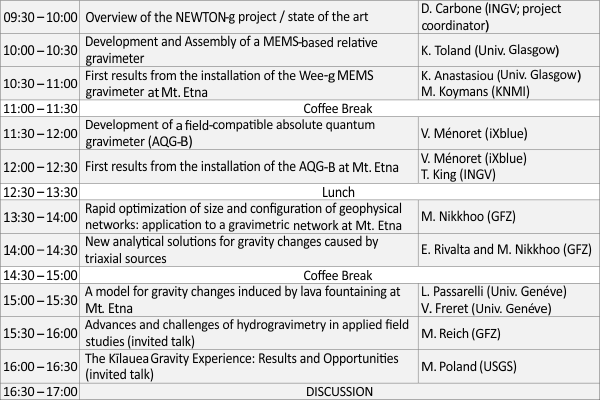 |
|
A Wee-g
installed on Etna
Posted on 12 August 2021 |
|
On 9 August, the first prototype of the Wee-g MEMS relative gravimeter was transported to Sicily by Kris Anastasiou and Steven Bramsiepe (UNIGLA-IGR). On 10 August, with support from
Alfio Messina e Danilo Contrafatto (INGV-OE team), they installed the device in the facilities of the Serra La Nave Astrophysical Observatory (SLN; 1,730 m elevation; ~6.5 km from the
summit craters of Mt. Etna; left panel below). The Wee-g is placed side-by-side with iGrav#16, one of the superconducting gravimeters which are part of the monitoring system of Mt. Etna,
managed by INGV-OE (middle panel in the picture below). Acquisition of data from the Wee-g and remote monitoring of the device are accomplished through the custom-designed data logger by
the INGV-OE team (Fasel-NEWTON-g board). The performance of the Wee-g
at Mt. Etna will be evaluated through comparison of data from the MEMS gravimeter and the iGrav. The feedback from this first installation will inform the implementation of
an array of Wee-g devices at Mt. Etna in the near future.
|
|
 |
|
Joint tests with the Wee-g and the Fasel-NEWTON-g board
Posted on 30 April 2021 |
|
To help ensure that the installation of Wee-g devices on Mount Etna is as seamless as possible, tests have been carried out by the UNIGLA-IGR team in Glasgow,
involving the Wee-g MEMS gravimeter and the Fasel-NEWTON-g datalogging board, developed by the INGV-OE team. UNIGLA-IGR and INGV-OE have engaged in conversation to determine
whether any further changes need to be made to allow for the successful installation of the Wee-g devices on Mt Etna.
|
|
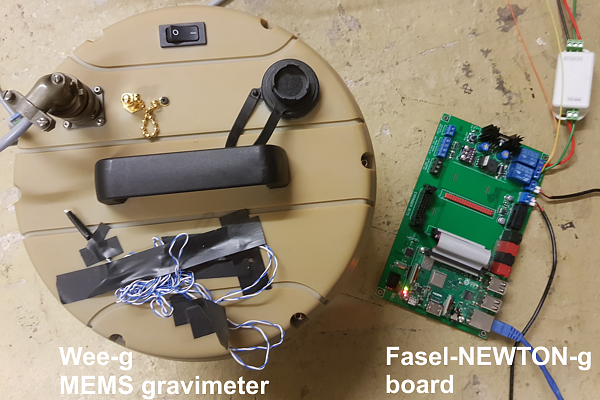 |
|
NEWTON-g at vEGU21
Posted on 27 April 2021 |
|
In the framework of Session
G4.4 at vEGU21, some NEWTON-g-related presentation will be given. In particular,
preliminary results from the installation of AQG-B03 at Mt. Etna are the focus
of EGU21-15186, entitled “Deploying and operating an Absolute Quantum Gravimeter on the summit of Mount Etna volcano”.
|
|
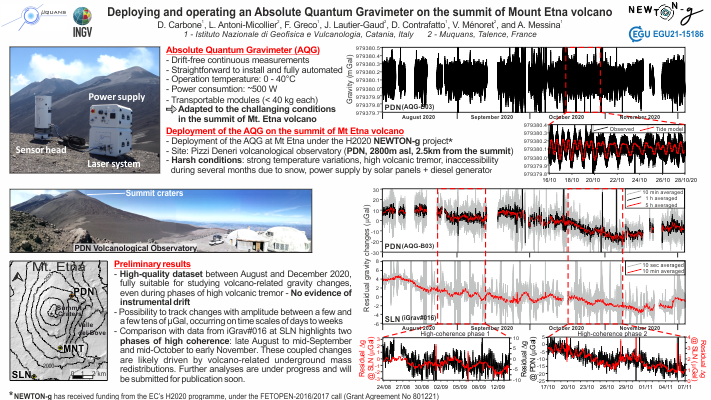 |
|
An update video on the MEMS gravimeter
Posted on 13 December 2020 |
|
The UNIGLA-IGR team has made significant progress on the development of the MEMS gravimeter to be utilized in the NEWTON-g’s gravity imager. An update video
from the team, giving an overview of the device features and the progress in laboratory and environmental testing that has been conducted so far, can be accessed from this
link.
The current version of the device, called Wee-g, has been designed
specifically for the NEWTON-g project. Several key features, such as its size, robustness, functionality and temperature control, have been designed to withstand the harsh environment in the summit
of Mt Etna.
|
|
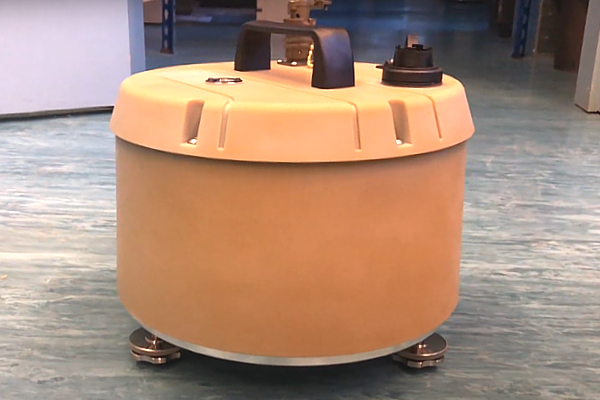 |
|
The first NEWTON-g paper is out!
Posted on 14 October 2020 |
|
The paper entitled “The NEWTON-g Gravity Imager: Toward New Paradigms for Terrain Gravimetry”, authored by the consortium of the project, has been published in Frontiers of Earth Science.
This article is an open access publication and can be reached through this link. In the paper we provide a complete insight into the rationale and objectives of NEWTON-g and present the actions
that have been taken and are planned for the near future, towards the development of the gravity imager and its installation on Mt. Etna.
|
|
 |
|
AQG-B03 alive and kicking on Etna
Posted on 22 September 2020 |
|
Less than two months after its installation at the Pizzi Deneri Volcanological Observatory (2800m elevation; upper northeastern flank of Mt. Etna),
where it has measured continuously at 2 Hz rate, AQG-B03 has already shown its potential to provide useful information on volcano-related subsurface
mass changes. Despite the high level of volcanic tremor that characterizes the installation site, the performance of the gravimeter are beyond expectations!
Indeed, meaningful gravity changes of limited amplitude have already been spotted over time scales between some hours and a few days. No instrumental drift
has been observed so far.
|
|
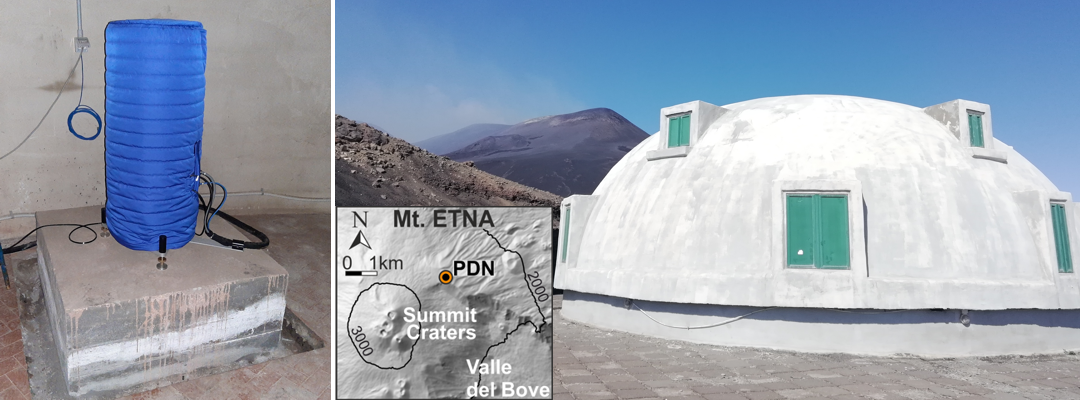 |
|
|
Top left: The AQG-B03 at PDN. It is installed on a concrete pillar, rooted in the rock underlying the building.
Top right: One of the domes of the
PDN observatory. The summit craters of Etna appear in the
background. Position of PDN shown in the inset.
Right: Time series of gravity during a ~1-month interval
(top: raw data dominated by earth tide; bottom: residual and
low-pass filtered data). |
|
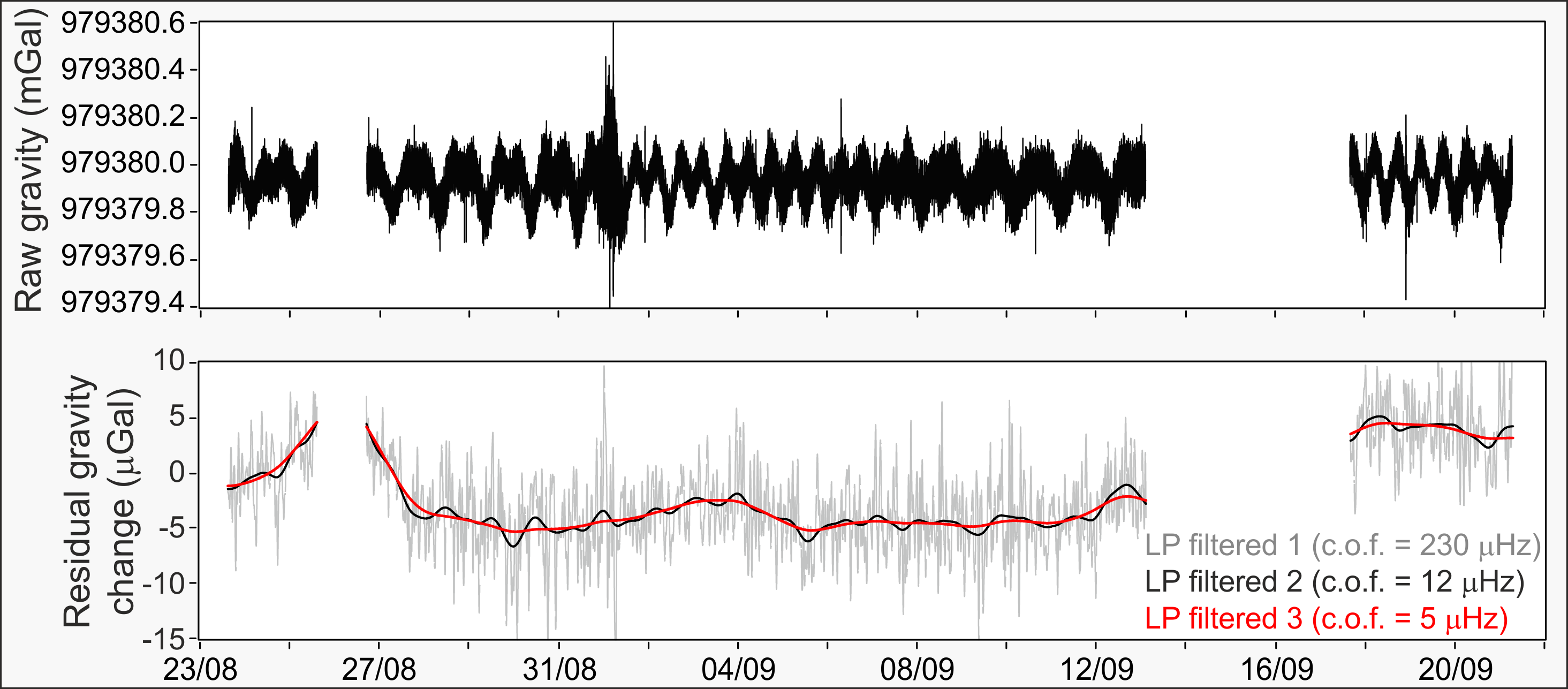 |
|
|
The AQG-B on its way to Etna!
Posted on 14 July 2020 |
|
The field version of the Absolute Quantum Gravimeter (AQG-B), developed by MUQUANS in the framework of NEWTON-g, is now on its way to Catania. Once it is delivered, we’ll acquire a time series
of gravity data at the Grav-Lab of INGV-OE for a few days, to check whether everything is alright with the instrument after the travel from France to Italy. If the AQG-B is proven to be in good
health, it will be moved to the Pizzi Deneri Volcanological Observatory (2800 m elevation), where it will continuously acquire absolute gravity data at a distance of only about 2.5 km from the
active summit craters of Etna. The volcanic tremor at this location is very intense and the main hurdle for the AQG-B will be to demonstrate that it can reject such high ground vibration noise.
This will be the first quantum gravimeter being utilized on an active volcano and the first absolute gravimeter performing continuous measurements in close vicinity to active volcanic structures!
|
|
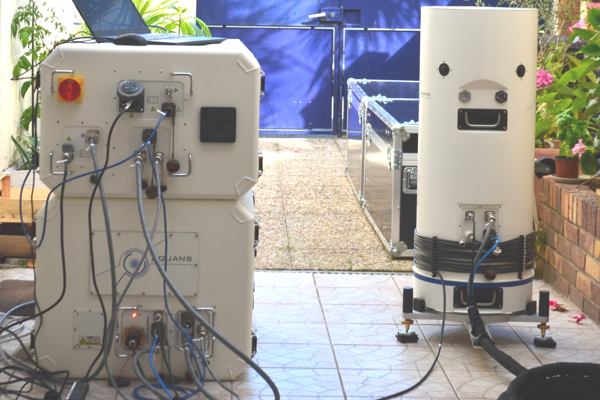 |
|
|
Impact of COVID-19 on the development of the MEMS gravimeter
Posted on 30 June 2020 |
|
Like many projects, the timeline of NEWTON-g has taken a significant impact from the COVID-19 pandemic.
As of the 23rd of March 2020, the University of Glasgow shut all its research facilities to
staff and students, in line with advice from the UK and Scottish Governments. This meant the UNIGLA-IGR group no longer had access to the Kelvin building, where the majority of research and testing
on the MEMS gravimeter was being carried out, and to the James Watt Nanofabrication Centre (JWNC), where the fabrication and assembly of the device happens.
Only a limited number of tests could be carried out remotely on the MEMS gravimeter; however, without access to the Kelvin building to make significant changes, the amount of R&D that can be performed is extremely
limited.
|
|
From the 1st of July, the University of Glasgow will gradually open up research facilities, but with significant restrictions in place, in accordance with
the Scottish Government’s guidelines. These measures are expected to have a significant impact on the ability to carry out the necessary R&D in a time efficient manner. As a consequence, our deployment schedule in
the summer of 2020 has been severely affected. It is hoped that, through the upcoming months, some of these restrictions will gradually be lifted to allow the UNIGLA-IGR group get back to its full working capabilities.
|
|
|
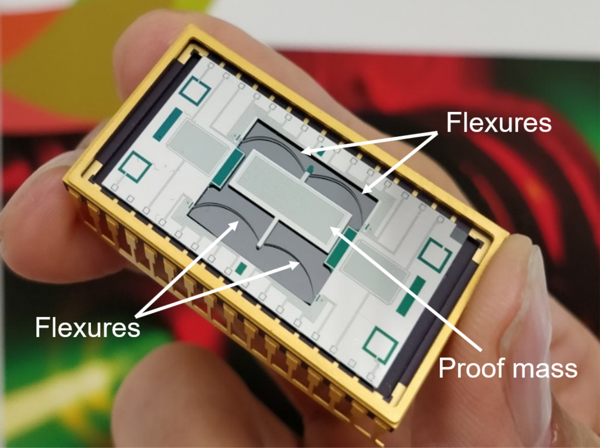 |
|
|
A fruitful and productive meeting in Catania
Posted on 16 February 2020 |
|
The “pre-deployment” meeting in Catania was a great occasion to share, among the partners, information on the state of progress of the different components involved
in the implementation of NEWTON-g and address all issues relevant to the field-test at Etna during the last two years of the project. We also held our 3rd General Assembly and had
a relaxing social dinner in the city center of Catania.
|
|
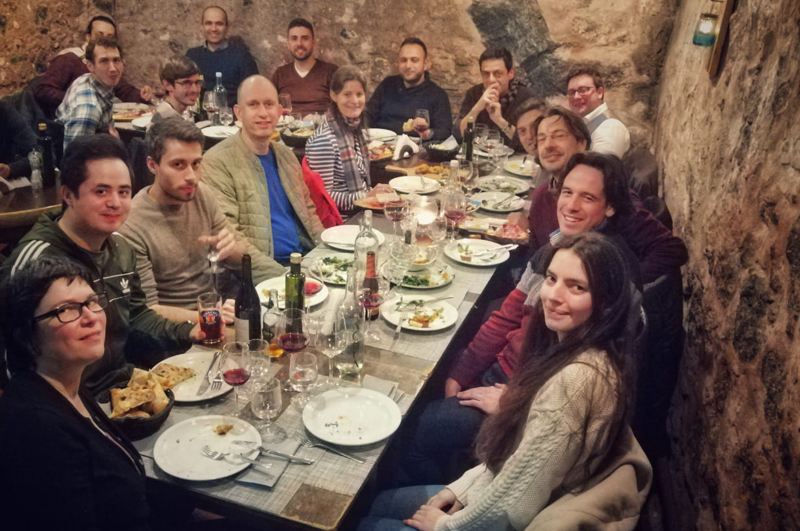 |
|
Pre-deployment meeting at INGV-OE
Posted on 16 January 2020 |
|
During 5 to 7 February 2020, the NEWTON-g consortium will meet at the headquarters of INGV-OE (Catania, Italy). The meeting is aimed to discuss the relevant
issues related to the deployment of the gravity imager on Etna (summer of 2020). In particular, we’ll discuss the state of the art of the current project phase
(production of the instrumentation) and will prepare a detailed plan for the deployment, including schedule of the joint tests involving different components
of the gravity imager.
|
|
 |
|
NEWTON-g-related
session at the EGU 2020 General Assembly
Posted on 9 January 2020 |
|
The NEWTON-g consortium is organizing a session of the EGU General Assembly 2020, in the framework of the Geodesy programme group. The session is entitled
“New tools for terrain gravimetry” and aims at bringing together experts in terrain gravimetry, applied to different fields (hydrology, volcanology, resource
exploitation), to discuss the state of the art and the opportunities offered by recent developments in instrumentation and methodology. Abstracts can be submitted
to the session through this link. The submission deadline is 15 Jenuary.
|
|
 |
|
The NEWTON-g video is out!
Posted on 4 October 2019 |
|
The NEWTON-g video has now been released!! It can be accessed from our homepage, or directly from the
YouTube channel of the project.
Short excerpts from the main video have also been published in our Twitter and
Facebook pages.
We are grateful to Gordon Ballantyne,
the Glasgow-based filmmaker who cured all the phases of the video production, from the interviews to representatives of the project partners,
to the final editing.
|
|
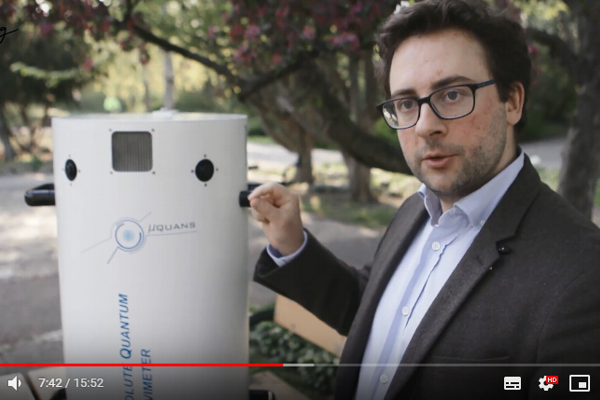 |
|
NEWTON-g presented at the 5th IAG Symposium on Terrestrial Gravimetry
Posted on 4 October 2019 |
|
In the framework of the 5th IAG
Symposium on Terrestrial Gravimetry: Static and Mobile Measurements (TG-SMM 2019), that was held in Saint Petersburg, Russia,
between 1 and 4 October 2019, Filippo Greco (INGV) gave an oral presentation on the work that is being carried out under NEWTON-g.
|
|
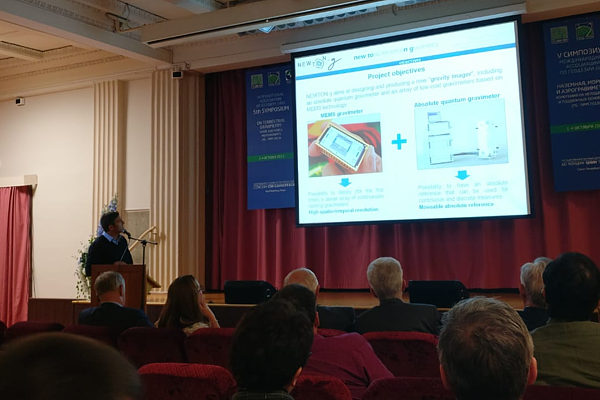 |
|
The new MEMS gravimeter presented in Japan
Posted on 23 September 2019 |
|
Prof. Giles Hammond (University of Glasgow) travelled to Japan in September 2019, as part of a British Embassy delegation focussing on quantum technologies.
During the visit he discussed the work on the relative MEMS gravimeter which is being readied for NEWTON-g deployment in mid 2020!
|
|
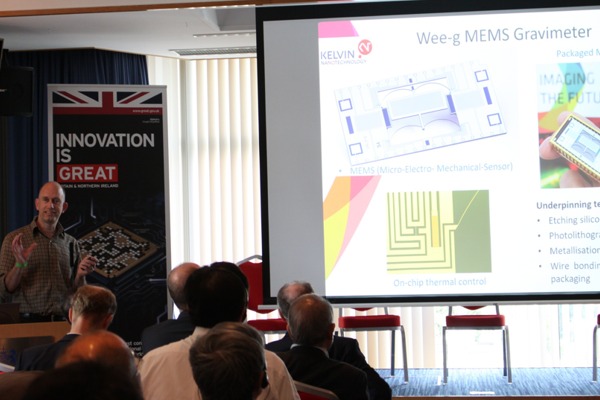 |
|
Pre-deployment field tests
Posted on 5 September 2019 |
|
During the last weeks, the INGV team ran several field tests in the summit zone of Etna, aimed at checking the performance of the chosen
components for the power, data acquisition and data transmission systems, that will be parts of the MEMS pixels in the gravity imager.
Furthermore, tests were carried out to check the reliability of the design for the field infrastructure that will host the MEMS
gravimeters during operation at Etna. We look forward to deploying the gravity imager next year!
|
|
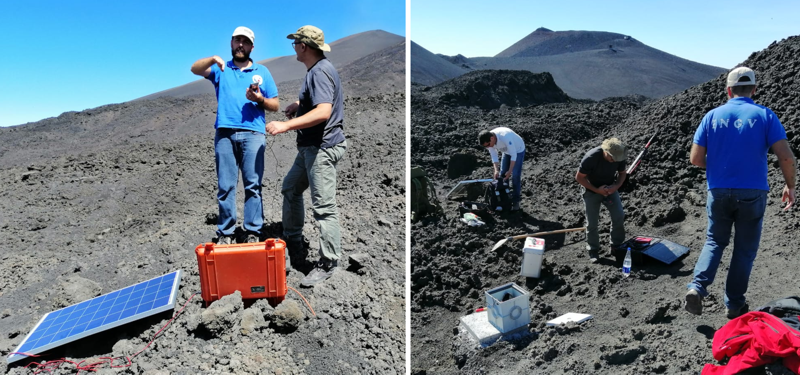 |
|
Looking for installation sites in the summit crater zone of Etna
Posted on 5 July 2019 |
|
On 28 June, Eleonora Rivalta (GFZ), Mehdi Nikkhoo (GFZ), Mathijs Koymans (KNMI), Daniele Carbone (INGV), and Filippo Greco (INGV) went on a field trip to the summit area of Etna.
The main aim of this field trip was to check whether suitable installation sites for the MEMS gravimeters are available in close vicinity to the sites
(yellow marks in the figure), resulting from the numerical procedure developed by the GFZ team. This algorithm is aimed at retrieving the optimal configuration of the gravimeters
forming the “gravity imager” of NEWTON-g. Only in some cases possible installation sites were found within a few meters from the “theoretical” ones. These
findings will inform further runs of the numeric procedure, towards the final configuration of the “gravity imager”.
|
|
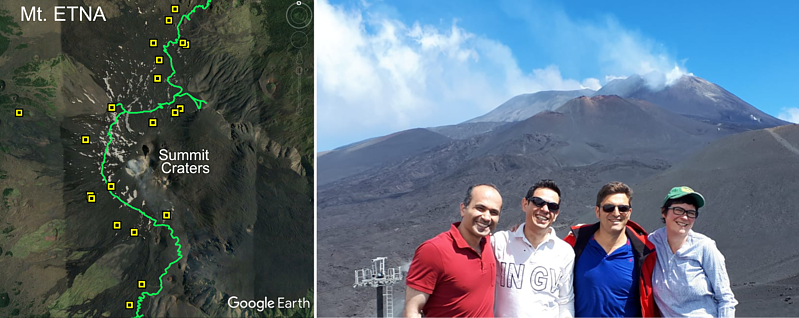 |
|
|
Article in the May 2019 issue of “La Recherche” magazine
Posted on 26 May 2019 |
|
An article in the May 2019 issue (n° 574) of “La Recherche” magazine (in French), entitled “Des atomes pour sonder la gravité”, focuses on the development
of Muquans’ cold-atom gravimeter and its field-test at Etna volcano, in the framework of NEWTON-g. You can read the article by following this
link.
|
|
 |
|
|
New meteo sensors in the summit zone of Etna
Posted on 13 May 2019 |
|
In order to precisely evaluate the effect that changes in groundwater mass may have on gravity changes observed in the summit zone of Etna,
we installed new meteo sensors at La Montagnola hut (MNT; 2600m a.s.l.). This is the site at higher elevation hosting one of the three
instruments in Etna’s mini-array of superconducting gravimeters (Carbone et al., 2019).
In view of the fied-test of the NEWTON-g gravity imager, the information provided by these sensors will enhance our ability to correct the gravity time series from Etna for the effect of groundwater mass, thus retrieving changes due to volcanic processes.
|
|
The picture shows the heated rain gauge (able to also measure the water equivalent of solid precipitations) and the
air temperature/humidity transducer that were installed, together with an underground probe measuring the soil volumetric
water content. These sensors are based on the MODBUS protocol and use RS485 communication to an Arduino module for data collection.
|
|
|
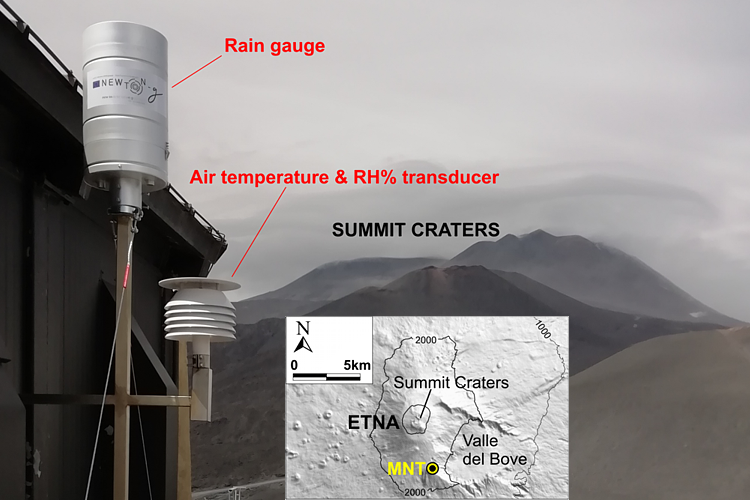 |
|
|
|
A busy week in Vienna
Posted on 16 April 2019 |
|
Besides giving two oral and one poster presentations about the recent developments of the project, the NEWTON-g consortium engaged in other
activities during the EGU 2019 week in Vienna (7–12 April 2019). Indeed, we held our 2nd General
Assembly on the 9th, where we discussed several issues related to the future implementation of NEWTON-g. Furthermore, G. Ballantyne, the filmmaker in charge of
producing the teaser movie of NEWTON-g, shot interviews to eight members of the consortium. We also managed to organize a social NEWTON-g
dinner!
|
|
|
|
In the pictures, clockwise from top-left, Daniele giving an oral
presentation on NEWTON-g, Laura presenting the NEWTON-g poster,
Jean being interviewed for the short video of the project,
Elske, Mehdi and Richerd discussing during a inter-session break of
the EGU meeting. |
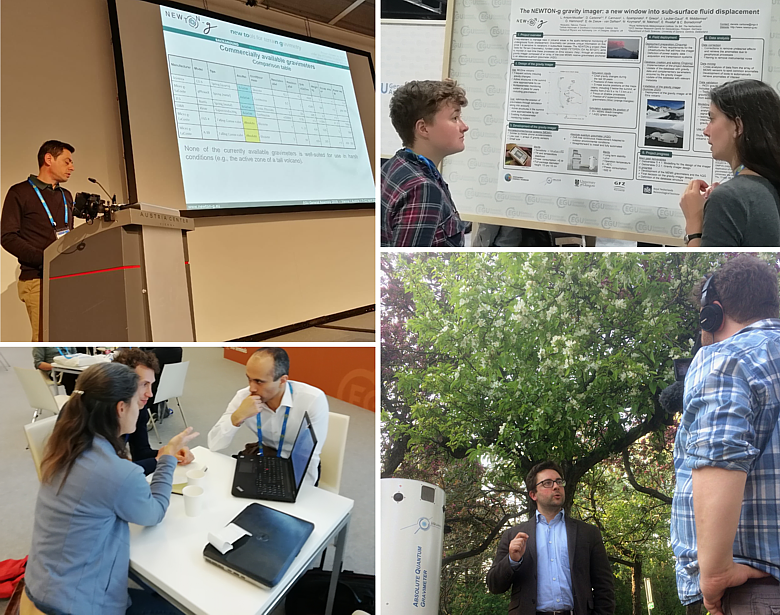 |
|
|
|
NEWTON-g @ the EGU 2019 General Assembly (Vienna, Austria, 7–12 April 2019)
Posted on 21 March 2019 |
|
The activities under NEWTON-g will be in the focus of three presentation at the EGU 2019 General Assembly:
|
|
|
The NEWTON-g gravity imager: a new window into sub-surface fluid displacement
Tue, 09 Apr, 14:00 - 15:45, Hall X1 (Session: GI1.1) |
|
|
Aplication of newly developed gravimeters to monitor and study active volcanoes: the NEWTON-g project
Thu, 11 Apr, 08:30 - 08:45, Room 2.21 (Session: GMPV5.2)
|
|
|
Optimization of network configuration for an array of low-cost gravimeters at Mount Etna
Thu, 11 Apr, 08:45 - 09:00, Room 2.21 (Session: GMPV5.2) |
 |
|
|
An update on NEWTON-g, given at the Institut de Physique de Globe de Paris
Posted on 14 February 2019 |
|
An update on the state of advancement of NEWTON-g was given last Monday (11 February) in the framework of the Workshop on Observatory Synergies for Astroparticle physics
and Geoscience (IPGP, Paris). Jean Lautier-Gaud, Giles Hammond and Daniele Carbone presented the background, motivation, and targets of NEWTON-g, as well as the state of development of the MEMS and quantum devices.
|
|
 |
|
|
NEWTON-g @ the Workshop on Observatory Synergies for Astroparticle physics and Geoscience
Posted on 4 February 2019 |
|
In the framework of the Workshop on Observatory Synergies for Astroparticle physics and Geoscience, that will be held at the Institut de Physique de
Globe de Paris on 11 and 12 February 2019, we will present the background, motivation and specific objectives of NEWTON-g. The 2-day workshop is organized by APPEC,
GEO-8 and Academia Europaea, in the presence of key science PIs and stakeholder agencies representatives. It is meant to foster the synergy between Geosciences
and Astroparticle Physics. All the information about the workshop, including rationale and timetable, can be found
here.
|
|
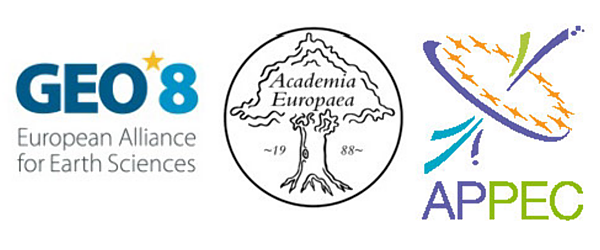 |
|
|
Season's Greetings
Posted on 22 December 2018 |
|
The NEWTON-g consortium wishs you a Merry Christmas and a happy New Year! |
|
 |
|
|
NEWTON-g at AGU Fall Meeting 2018
Posted on 6 December 2018 |
|
Next week, NEWTON-g will be represented at the AGU fall meeting in Washington!
Muquans will give an oral presentation on Friday, December 14th about quantum gravimetry and how it can be used to monitor volcanic activity. We will be hosted by session
G013: Gravity Field Determination: Acquisition, Processing, and
Geodetic Applications of Terrestrial, Marine, and Airborne
Gravity Data (abstract). |
|
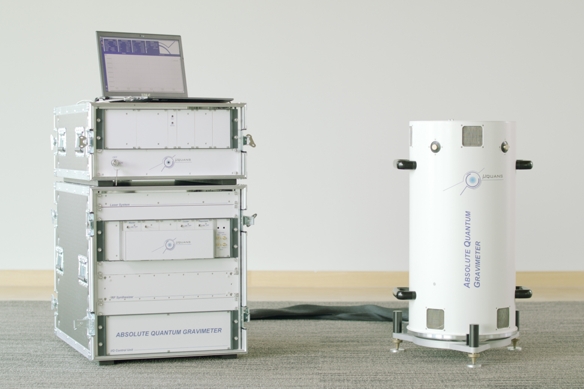 |
|
|
A fruitful
workshop!
Posted on 12 October 2018 |
|
The first workshop of NEWTON-g, held at Potsdam (Germany) on 9 and 10 October 2018, was a really
fruitful, interesting and well organized one!
On the 9th, the consortium met in the conference room of GFZ section 2.1 and discussed issues related to the state
of advancement of the project, the upcoming deliverables and milestones. The end of the meeting day was devoted to group discussions, focused on particular aspects
of the project implementation.
On the 10th, the workshop was hosted at the Bildungsforum in Potsdam, where the project partners met scientists
from different institutions. The vision and objectives of the project were thoughtfully presented by the consortium members
to the audience of gravity enthusiasts and then a discussion was held on scientific and technical issues related to the implementation of NEWTON-g.
We are grateful to Eleonora and Mehdi (GFZ) for organizing and hosting the workshop and to all the colleagues who
joined us on the 10th, for the precious feedback they provided.
The pictures below show Richard (up; UNIGLA-IGR) and Jean (down; MUQUANS) telling us about the beauty of the MEMS and quantum devices in the measuring system proposed by NEWTON-g.
|
|
 |
|
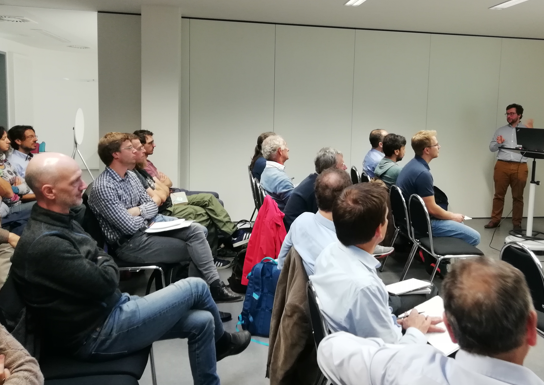 |
|
|
Kick off workshop of NEWTON-g (9
and 10 October 2018 - GFZ, Germany)
Posted on 21 September 2018 |
|
The first workshop of NEWTON-g will be held in the facilities of GFZ (Potsdam, Germany), on 9 and 10 October 2018. During the first day, the consortium will discuss
internally issues concerning the state of advancement of the project and upcoming deadlines. During the second day (10 October; 09:00 – 15:00), the workshop will be open to participants from outside the consortium.
The agenda of the second workshop day can be found
here. |
|
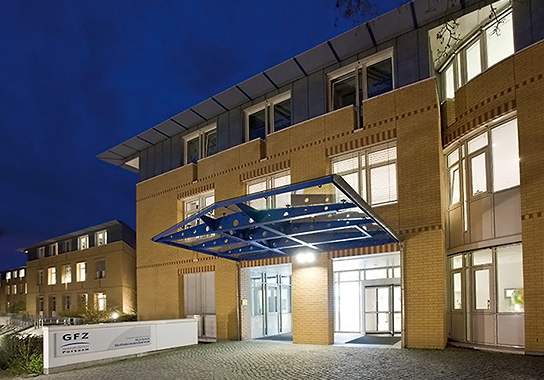 |
|
|
Welcome, Mehdi!
Posted on 14 September 2018 |
|
On 1 September, Mehdi Nikkhoo has joined the “Magma propagation” research group led by Eleonora Rivalta
at GFZ, to work on task 4.3 (Numerical modelling) of NEWTON-g. His task is defining the temporal variations in the gravity field expected at Mt Etna during
subsurface mass redistributions linked to magmatic activity. The synthetic signals from the modelling will be at first validated based on the recordings from INGV
gravity network, and later applied to interpret the data produced by the NEWTON-g gravity imager.
Mehdi did his M.Sc. studies in geodesy concentrating on regional gravity field modeling and geoid determination through combining satellite gravity models and
heterogeneous terrestrial data. He then pursued his Ph.D. research in volcano geodesy with the focus on developing new analytical and numerical techniques for
modelling crustal deformations. He has routinely utilized these modelling techniques to constrain the location, geometry and intensity of various magmatic and
tectonic processes through inverting the ground deformation signals that they produced (www.volcanodeformation.com).
|
|
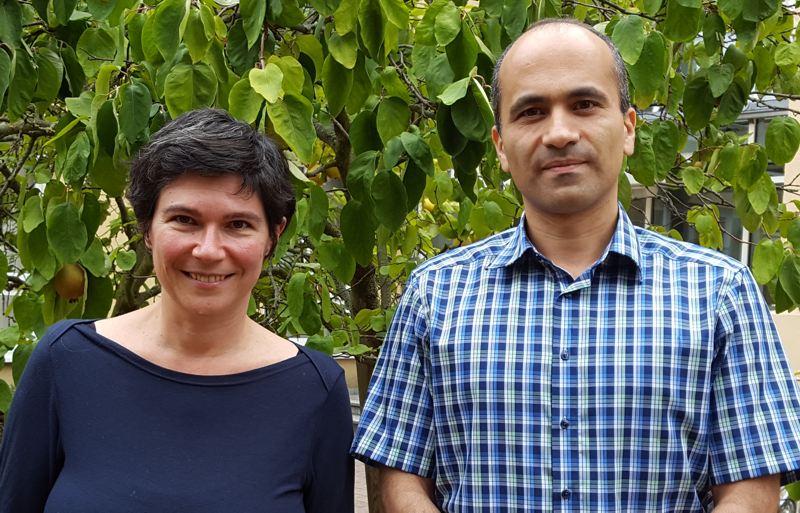 |
| |
|
Etna field trip
Posted on 13 August 2018 |
|
On 20 June 2018, a field trip was arranged, involving the project partners and aimed at visiting possible sites on the summit zone
of Etna where the “gravity imager” could be installed. In spite of unfavourable weather conditions, it was possible to reach most candidate installation sites (at elevations up to 2600m),
thus getting a clear idea of the ambient conditions that the measuring system will have to withstand. |
|
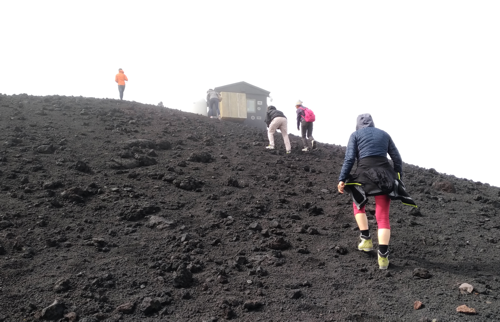 |
|
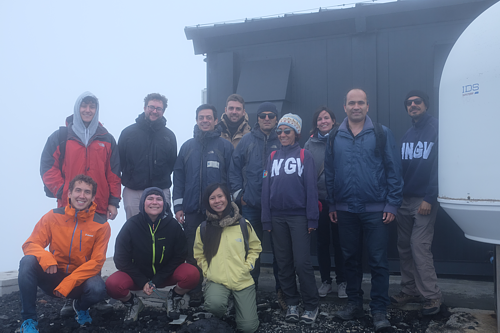 |
|
|
|
NEWTON-g kick-off meeting
Posted on 13 August 2018 |
|
The kick-off meeting of NEWTON-g was held on June 18 and 19, 2018, in the Catania Section (Osservatorio Etneo) of INGV.
The main objectives of the meeting were (i) setting the official start of the project, (ii) establishing direct relations among the project partners, (iii) discuss the specific actions
to be carried out in the following months, and (iv) providing details on administrative issues.
The final agenda of the meeting can be found
here. |
|
 |